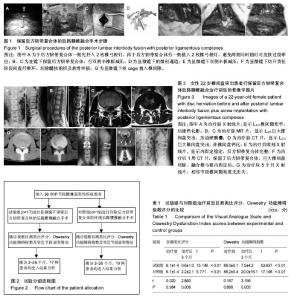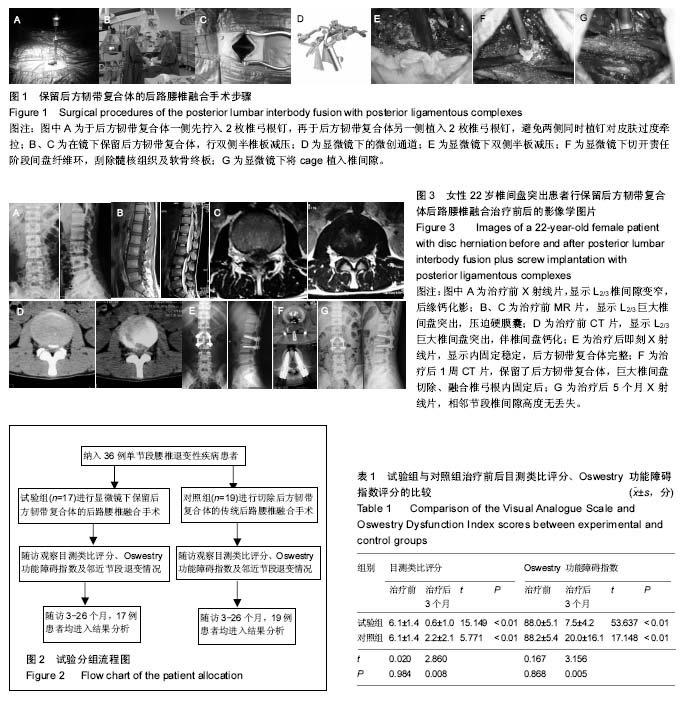Chinese Journal of Tissue Engineering Research ›› 2017, Vol. 21 ›› Issue (23): 3682-3687.doi: 10.3969/j.issn.2095-4344.2017.23.013
Previous Articles Next Articles
Posterior lumbar interbody fusion plus screw implantation with posterior ligamentous complexes under microscope for lumbar degenerative disease
Ji Jing-tao, Miao Jun, Li Wen-jun, Zhu Shan
- Tianjin Hospital, Tianjin 300211, China
-
Online:2017-08-18Published:2017-09-01 -
Contact:Miao Jun, Chief physician, Master’s supervisor, Tianjin Hospital, Tianjin 300211, China -
About author:Ji Jing-tao, M.D., Attending physician, Tianjin Hospital, Tianjin 300211, China -
Supported by:the National Natural Science Foundation of China, No. 81472140; the Science and Technology Project of Tianjin Municipal Bureau of Health, No.15KG124
CLC Number:
Cite this article
Ji Jing-tao, Miao Jun, Li Wen-jun, Zhu Shan. Posterior lumbar interbody fusion plus screw implantation with posterior ligamentous complexes under microscope for lumbar degenerative disease [J]. Chinese Journal of Tissue Engineering Research, 2017, 21(23): 3682-3687.
share this article

2.1 参与者数量分析 36例患者均完成治疗后3-26个月的门诊随访,进入结果分析。 2.2 试验分组流程图 见图2。 2.3 两组基线资料比较 两组患者性别比例、年龄、病变部位、疾病类型等基线资料比较差异无显著性意义,具有可比性。 2.4 手术情况 试验组手术时间70-140 min,平均 130 min;术中出血量100-800 mL,平均260 mL。对照组手术时间90-150 min,平均145 min;术中出血量400- 1 200 mL,平均640 mL。 2.5 疼痛缓解 36例患者术后24 h后腰腿痛症状均有不同程度缓解,8例患者术后拔出引流管后出现单侧下肢疼痛、麻木症状,经过神经营养、脱水药物及小剂量激素治疗后症状缓解。试验组3例患者随访期间偶有腰部不适症状,通过休息或口服非类固醇抗炎药物均可缓解,17例患者随访期间腰腿痛症状无复发。对照组11例患者随访期间平卧时出现腰部不适症状,6例患者腰痛明显,需借助腰围或口服非类固醇抗炎药物缓解。 2.6 目测类比评分与Oswestry功能障碍指数评分的比较 治疗前,两组间目测类比评分、Oswestry 功能障碍指数评分比较差异均无显著性意义;两组治疗后3个月的目测类比评分、Oswestry 功能障碍指数评分均明显低于治疗前(P < 0.01),试验组治疗后3个月的目测类比评分、Oswestry 功能障碍指数评分明显低于对照组(P < 0.01),见表1。 2.7 影像学检查结果 试验组2例出现手术节段头侧椎间隙高度丢失> 3 mm,但未发生椎体位移。对照组 8例出现手术节段头侧椎间隙高度丢失> 3 mm,2例出现手术节段头侧椎体前滑移>3 mm,同时存在动力位下椎间隙角度变化> 5°。 2.8 置钉后腰椎稳定性 术后36例患者随访期间X射线片显示内固定稳定,无椎间cage松动、退出,无椎弓根钉松动、断裂或脱出等并发症发生。 2.9 植入材料不良反应 此次研究中两组均未发生与植入材料相关的不良反应。 2.10 典型病例影像学图片 见图3。"

| [1] Cloward RB.Spondylolisthesis: treatment by laminectomy and posterior interbody fusion.Clin Orthop Relat Res. 1981; (154):74-82.[2] Shriver MF,Lubelski D,Sharma AM,et al.Adjacent segment degeneration and disease following cervical arthroplasty: a systematic review and meta-analysis.Spine J.2016;16(2): 168-181.[3] Virk SS,Niedermeier S,Yu E,et al.Adjacent segment disease. Orthopedics.2014;37(8):547-555.[4] Nakashima H,Kawakami N,Tsuji T,et al.Adjacent Segment Disease After Posterior Lumbar Interbody Fusion: Based on Cases With a Minimum of 10 Years of Follow-up.Spine(Phila Pa 1976).2015;40(14):E831-841.[5] St-Pierre GH,Jack A,Siddiqui MM,et al.Nonfusion Does Not Prevent Adjacent Segment Disease: Dynesys Long-term Outcomes With Minimum Five-year Follow-up.Spine(Phila Pa 1976).2016;41(3):265-273.[6] Xia XP,Chen HL,Cheng HB.Prevalence of adjacent segment degeneration after spine surgery: a systematic review and meta-analysis.Spine(Phila Pa 1976).2013;38(7):597-608.[7] Ren C,Song Y,Liu L,et al.Adjacent segment degeneration and disease after lumbar fusion compared with motion-preserving procedures: a meta-analysis.Eur J Orthop Surg Traumatol. 2014;24:245-253.[8] Goel VK,Kim YE,Lim TH,et al.An analytical investigation of the mechanics of spinal instrumentation.Spine. 1988;13(9): 1003-1011.[9] Moskowitz A.Transforaminal lumbar interbody fusion.Orthop Clin North Am.2002;33(2):359-366.[10] Liu H,Wu W,Li Y,et al.Protective effects of preserving the posterior complex on the development of adjacent-segment degeneration after lumbar fusion.J Neurosurg Spine. 2013; 19(2):201-206.[11] Lai PL,Chen LH,Niu CC,et al.Relation between laminectomy and development of adjacent segment instability after lumbar fusion with pedicle fixation.Spine(Phila Pa 1976).2004;29(22):2527-2532. [12] Ekman P,Möller H,Shalabi A,et al.A prospective randomised study on the long-term effect of lumbar fusion on adjacent disc degeneration.Eur Spine J.2009;18(8): 1175-1186.[13] Kim HJ,Kang KT,Moon SH,et al.The quantitative assessment of risk factors to overstress at adjacent segments after lumbar fusion: removal of posterior ligaments and pedicle screws.Spine(Phila Pa 1976).2011; 36(17):1367-1373.[14] Chen BL,Wei FX,Ueyama K,et al.Adjacent segment degeneration after single-segment PLIF: the risk factor for degeneration and its impact on clinical outcomes.Eur Spine J.2011;11:1946-1950.[15] Wai EK,Santos ER,Morcom RA,et al.Magnetic resonance imaging 20 years after anterior lumbar interbody fusion.Spine(Phila Pa 1976).2006;31(17):1952-1956.[16] Chen CS,Feng CK,Cheng CK,et al.Biomechanical analysis of the disc adjacent to posterolateral fusion with laminectomy in lumbar spine.J Spinal Disord Tech.2005; 18(1):58-65.[17] Chen LH,Lai PL,Tai CL,et al.The effect of interspinous ligament integrity on adjacent segment instability after lumbar instrumentation and laminectomy-an experimental study in porcine model.Biomed Mater Eng.2006;16: 261-267.[18] Tai CL,Hsiesh PH,Chen WP,et al.Biochemical comperison of lumbar spine instability between laminectomy and bilateral laminotomy for spinal stenosis syndrome-an experimental study in porcine model.BMC Musculoskelet Disord.2008; 11:84.[19] Kato Y,Punjabi M,Nibu K.Biochemical study of lumbar spinal stability after osteoplastic laminectomy.J Spinal Disord.1998; 11:146-150.[20] Arnoldi CC,Brodsky AE,Cauchoix J,et al.Lumbar spinal stenosis and nerve root entrapment syndromes: Definition and classification.Clin Orthop Relat Res.1976;115:4-5. [21] Verbiest H.Results of surgical treatment of idiopathic developmental stenosis of the lumbar vertebral canal; Areview of twenty-seven years experience.J Bone joint Surg Br.1977;59(2):181-188.[22] Turner JA,Ersek M,Herron L,et al.Surgery for lumbar spinal stenosis: attempted meta-analysis of the literature.Spine(Phila Pa 1976).1992;17(1):1-84. [23] Atlas JA,Deyo RA,Keller RB,et al.The Maine lumbar spine study Part III: 1 year outcomes of surgical and nonsurgical management of lumbar spinal stenosis.Spine(Phila Pa 1976). 1996;21:1787-1795. [24] Thomas NW,Rea GL,Pikul BK,et al.Quantitative outcome and radiographic comparisons between laminectomy and laminotomy in the treatment of acquired lumbar stenosis. Neurosurgery.1997;41:567-575.[25] Postacchini F,Cinotti G,Perugia D,et al.The surgical management of central lumbar stenosis: multiple laminotomy compared with total laminectomy.J Bone Joint Surg Br.1993; 75(3):386-392.[26] Johnson B,Annertz M,Sjoberg C,et al.A progressive and consecutive study of surgically treated lumbar spinal stenosis.Part II; Five year follow-up by an independent observer.Spine(Phila Pa 1976).1997;22:2938-2944. [27] Johnson B,Annertz M,Sjoberg C,et al.A progressive and consecutive study of surgically treated lumbar spinal stenosis.Part I: Clinical features related to radiographic findings.Spine(Phila Pa 1976).1997;22:2932-2937. [28] Shenkin HA,Hash CJ.Spondylolisthesis after multiple bilateral laminectomies and facetectomies for lumbar spondylosis. Follow-up review.J Neurosurg.1979;50:45-47. [29] Lee CK.Lumbar spine instability (olisthesis) after extensive posterior spinal decompression.Spine(Phila Pa 1976).1983;8: 429-432.[30] Arnoldi CC,Brodsky AE,Cauchoix J,et al.Lumbar spinal stenosis and nerve root entrapment syndromes: Definition and classification.ClinOrthopRelat Res.1976;115:4-5. [31] Wang J,Zhou Y,Zhang ZF,et al.Minimally invasive or open transforaminal lumbar interbody fusion as revision surgery for patients previously treated by open discectomy and decompression of the lumbar spine.Eur Spine J.2011;20: 623-628. [32] Tian NF,Wu YS,Zhang XL,et al.Minimally invasive versus open transforaminal lumbar interbody fusion: A meta-analysis based on the current evidence.Eur Spine J.2013;22: 1741-1749. [33] Goldstein CL,Macwan K,Sundararajan K,et al.Comparative outcomes of minimally invasive surgery for posterior lumbar fusion: A systematic review.Clin Orthop Relat Res.2014;472: 1727-1737. [34] Pan L,Zhang P,Yin Q.Comparison of tissue damages caused by endoscopic lumbar discectomy and traditional lumbar discectomy: A randomised controlled trial.Int J Surg.2014;12: 534-537. [35] Wang J,Zhou Y,Feng Zhang Z,et al.Comparison of the clinical outcome in overweight or obese patients after minimally invasive versus open transforaminal lumbar interbody fusion. J Spinal Disord Tech.2014;27:202-206.[36] Evaniew N,Khan M,Drew B,et al.Minimally invasive versus open surgery for cervical and lumbar discectomy: a systematic review and meta-analysis.CMAJ Open.2014;2(4): E295-305. |
| [1] | Yao Xiaoling, Peng Jiancheng, Xu Yuerong, Yang Zhidong, Zhang Shuncong. Variable-angle zero-notch anterior interbody fusion system in the treatment of cervical spondylotic myelopathy: 30-month follow-up [J]. Chinese Journal of Tissue Engineering Research, 2022, 26(9): 1377-1382. |
| [2] | Zhang Jinglin, Leng Min, Zhu Boheng, Wang Hong. Mechanism and application of stem cell-derived exosomes in promoting diabetic wound healing [J]. Chinese Journal of Tissue Engineering Research, 2022, 26(7): 1113-1118. |
| [3] | An Weizheng, He Xiao, Ren Shuai, Liu Jianyu. Potential of muscle-derived stem cells in peripheral nerve regeneration [J]. Chinese Journal of Tissue Engineering Research, 2022, 26(7): 1130-1136. |
| [4] | Yang Jun, Yang Qun, Zhang Rui, Jiang Chang. A novel slidable pedicle screw-rod system for lumbar tuberculosis: promoting bone graft fusion by producing stress stimulation to fused segment [J]. Chinese Journal of Tissue Engineering Research, 2022, 26(6): 914-918. |
| [5] | Li Jian, Bao Zhengqi, Zhou Pinghui, Zhu Ruizhi, Li Zhixiang, Wang Jinzi. Effects of posterior single open-door laminoplasty and anterior cervical corpectomy fusion on cervical sagittal balance parameters in the treatment of multilevel cervical spondylotic myelopathy [J]. Chinese Journal of Tissue Engineering Research, 2022, 26(6): 949-953. |
| [6] | He Yunying, Li Lingjie, Zhang Shuqi, Li Yuzhou, Yang Sheng, Ji Ping. Method of constructing cell spheroids based on agarose and polyacrylic molds [J]. Chinese Journal of Tissue Engineering Research, 2022, 26(4): 553-559. |
| [7] | He Guanyu, Xu Baoshan, Du Lilong, Zhang Tongxing, Huo Zhenxin, Shen Li. Biomimetic orientated microchannel annulus fibrosus scaffold constructed by silk fibroin [J]. Chinese Journal of Tissue Engineering Research, 2022, 26(4): 560-566. |
| [8] | Chen Xiaoxu, Luo Yaxin, Bi Haoran, Yang Kun. Preparation and application of acellular scaffold in tissue engineering and regenerative medicine [J]. Chinese Journal of Tissue Engineering Research, 2022, 26(4): 591-596. |
| [9] | Kang Kunlong, Wang Xintao. Research hotspot of biological scaffold materials promoting osteogenic differentiation of bone marrow mesenchymal stem cells [J]. Chinese Journal of Tissue Engineering Research, 2022, 26(4): 597-603. |
| [10] | Shen Jiahua, Fu Yong. Application of graphene-based nanomaterials in stem cells [J]. Chinese Journal of Tissue Engineering Research, 2022, 26(4): 604-609. |
| [11] | Zhang Tong, Cai Jinchi, Yuan Zhifa, Zhao Haiyan, Han Xingwen, Wang Wenji. Hyaluronic acid-based composite hydrogel in cartilage injury caused by osteoarthritis: application and mechanism [J]. Chinese Journal of Tissue Engineering Research, 2022, 26(4): 617-625. |
| [12] | Li Hui, Chen Lianglong. Application and characteristics of bone graft materials in the treatment of spinal tuberculosis [J]. Chinese Journal of Tissue Engineering Research, 2022, 26(4): 626-630. |
| [13] | Gao Cangjian, Yang Zhen, Liu Shuyun, Li Hao, Fu Liwei, Zhao Tianyuan, Chen Wei, Liao Zhiyao, Li Pinxue, Sui Xiang, Guo Quanyi. Electrospinning for rotator cuff repair [J]. Chinese Journal of Tissue Engineering Research, 2022, 26(4): 637-642. |
| [14] | Feng Shuo, Liu Bo, He Da. Effects of robot-assisted percutaneous minimally invasive pedicle screw placement in oblique lumbar interbody fusion [J]. Chinese Journal of Tissue Engineering Research, 2022, 26(3): 408-413. |
| [15] | Guan Jian, Jia Yanfei, Zhang Baoxin , Zhao Guozhong. Application of 4D bioprinting in tissue engineering [J]. Chinese Journal of Tissue Engineering Research, 2022, 26(3): 446-455. |
| Viewed | ||||||
|
Full text |
|
|||||
|
Abstract |
|
|||||